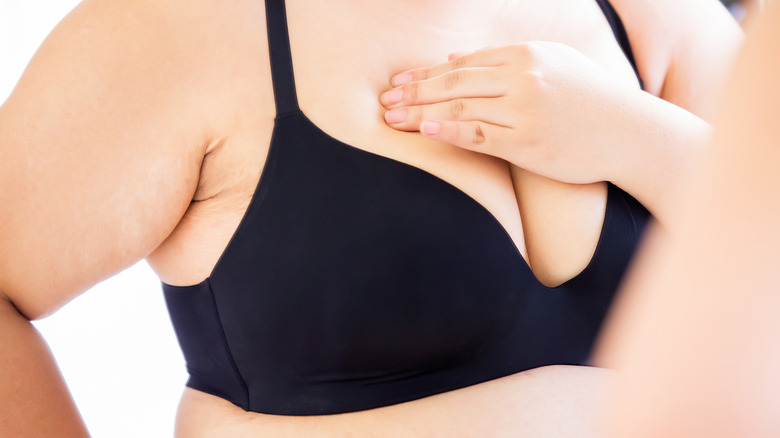If You Notice This On Your Breast It Could Be A Sign Of Breast Cancer
Breast self-exams can be helpful for early detection of cancer. But simply being aware of your breasts' appearance is also important, as changes in texture and color could be an indication of something more going on.
When breast cancer is detected through self-examination, it's sometimes detected early, making treatment more likely to be successful (via Breastcancer.org). Combined with other screening methods like mammograms and physicals, self-exams can increase the odds of early detection. While the American Cancer Society no longer recommends regular self-exams for those with an average risk of breast cancer, they still recommend becoming familiar with the normal way your breasts look and feel, and reporting any changes to your doctor.
When performing a self-exam, you should first do a visual examination and notice the breasts' usual size, shape, and color (per Breastcancer.org). You can do this in front of a mirror, with your hands on your hips as well as raised over your head. Pay attention to the nipples if they've changed position or become inverted, and look for any redness, rash, swelling, or soreness. Consult your doctor if you have any of these signs, or if you notice puckering or bulging of the skin. Another important symptom to look out for is dimpling of the breast tissue, which can happen for a few different reasons but can sometimes be a sign of a certain type of breast cancer (via Medical News Today).
Dimpling is a sign to get checked
Dimpling of the breast means that the skin looks like the peel of an orange, pitted and uneven (via Medical News Today). It can also appear red and inflamed. Skin near the breast, nipple, or areola could become red, scaly, or swollen, and the tissue could thicken.
If you notice dimpling in just one breast, it may be a sign of inflammatory breast cancer, an aggressive form of cancer that attacks the lymph vessels and skin, blocking the lymphatic draining in the breasts. There's often no lump present, and skin symptoms often won't appear until the cancer is in stage III or stage IV. It occurs more commonly in younger women, though it only makes up about 1-5% of all breast cancers.
If dimpling happens in both breasts, it's probably not cancer, but may be fat necrosis, a condition that causes fatty tissue in the breasts to die. This can happen due to injury, surgery, or as a side effect of a biopsy. It might cause a lump as well, but there's no connection between fat necrosis and breast cancer.
If you notice dimpling on your breast tissue, see your doctor for an examination to determine the cause.


